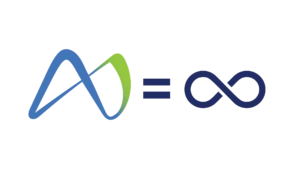humanize – the ‘logo’logue
We have always told stories as anecdotes to establish a fact and make it interesting. Let me tell you a few stories, which are not meant to establish any logic, but stories that inspired us to design the creatives of humanize.
Story I: What’s in a name?
When my parents named me, it seems there was a lot of discussion—like I assume is true for all families. From my experience, it’s usually an engaged conversation not just for the parents but also within the immediate family. In my case, and like in most Bengali families, it was no different.
I think naming anything is similar; people who believe in the product or company are passionate about the process and often have strong opinions.
I believe that one should be. I’m from the school of thought that a name is not just where things start, but it is also what connects and reminds you of your purpose.

So, when we first started thinking of our business in the world of AI—amid all the rhetoric about job losses due to AI, AI ruling the world, or the ethics of AI—we thought of two key drivers around which we would build our business:
- Humans and AI will collaborate, not compete, for a more efficient world.
- Businesses and society will benefit from the efficiency of AI, but will also need human values such as listening, empathy, and right conduct to make businesses sustainable.
This led to the coming together of “human” and “AI” in our name, humanize. We also wanted to ensure that when we write the name, we always use lowercase letters to represent humility—a key aspect and trait that we aim to inculcate in every member of Team humanize.
Story II: The human angle
In World War II, there were a lot of planes that used to come down due to anti-aircraft fire. Some of them were managing to come back to the air base, but a lot of them were getting lost. So, the Air Force decided to put together a small team of Air Force Officers, Math geniuses, scientists, and engineers in order to create a small consulting team to find out what they could do to protect these planes. What they actually wanted to do was put armor around the plane. The planes could only take that much extra weight, so they had to decide where exactly on the plane to put the armor without affecting the aerodynamic balance. They identified all the bullet holes per square foot across the length of the plane and realized that the tail section had 1.98 bullet holes per square foot whereas the nose section had 1.1 bullet holes per square foot. The Air Force officer said, “We should obviously, put armor at the tail end section as that’s where more holes were”. However, there was a Math genius called Abraham Wald who said quite the opposite. To everyone’s surprise, he said, “We need to put the armor in the nose section of the aircraft because we are measuring planes that have come back. The planes that have a high number of bullet holes in the nose section never survived. We need to protect the nose section.”

This story, while a common one, is of applicability of human acumen bringing in a human-centric solution! Had it been AI, getting the modeling done from the training data it had received (1.98 bullet holes at the tail of the aircraft), it would have recommended building the armor at the tail of the aircraft. Collaboration between humans and machines, complementing each other’s strengths of acceleration and acumen is the philosophy of humanize.
Story III: The circle of evolution
I am a big fan of sports, and I keep making conscious efforts to bring learnings from the world of sports to my work. This is the story of Novak Djokovic, a star tennis player, whom I first read about on a Billy Oppenheimer blog. It’s the 2nd of June, 2010. The French Open is underway at the Ronald Garros in Paris. Novak Djokovic was seeded No 3 in this tournament and on this day, he was playing in the quarter-final against Jurgen Melzer who was seeded 22. Djokovic was up two sets. In his career by then, Djokovic had been up two sets 49 times and had won all 49. But today was different. He lost! A few days after losing, Novak Djokovic told his coach, Marián Vajda, that he decided to quit playing tennis. Without reacting too much to it, Marian asked Novak a question, “What is the reason you started playing tennis”. Novak replied instantly “I feel happy when I hold that racket in my hand”. While he was uttering those words, the realization which came to Novak and triggered his journey of continuous evolution, changed the course of his life and the history of tennis. He evolved as a player, he expanded his skills on grass and on clay courts, overcame injuries, and took his game to the level of an unmatched level. If I have to take this story into the business context, clients do not use technology just to modernize their IT real estate, they do that to solve a business problem. Also, transformation is not a point-in-time activity, it is continuous, incremental, and seamless, with a common objective to become better – the essence of ‘continuous evolution’ in business.

We at humanize, aim to be the catalyst of the continuous business evolution of clients, and hence the relevance of the infinite loop in our logo.
Story IV: Colors of life
Have you ever wondered why Apple introduced white-coloured earphones? This interesting story demonstrates that going against Social Proof (a term coined by Robert Cialdini in his famous book Influence – The Psychology of Persuasion) can differentiate one as a new entrant. The theory of Social Proof states people assume that if many others are doing something, then it must be correct. When Apple was planning to launch its flagship product earpods, the competitors that existed in the market were the headbands with black colors. So how to stand out and create social proof that is against the norm? Apple came up with the milk-white color AirPods and no other variants. One can notice it from far, crowded streets of Manhattan to a laid-back beach in Maine, Apple AirPods stood out – It was an instant success! When we were internally discussing the construct of the logo, we were quite convinced of the combination of elements expressing ‘AI, Human, Evolution’ in our logo. The question was how to make us stand apart. When we looked at most of our competitors, we found logos were separate from that of the company name, and mostly in monotone or dual-tone. humanize logo is a unique harmony and co-existence of the ‘name and the symbol’ – one flowing to the other. The font used in the logo is ‘Techead’– an innovative sans serif font family. Techead embodies simplicity, and confidence, and is specially designed for technology start-ups focused on developing sustainable and innovative businesses, which perfectly aligns with the purpose of humanize as a company.
Apart from the core team of founders that worked on it I want to thank the marketing team of NLB for helping spread the story so effectively and Buffalo Soldiers for going through multiple iterations and their patience in developing the logo.. humanize is ready to do what it has promised to do and what its name suggests .. human and AI together.
Here’s presenting to you the identity of humanize

humanize is an innovative technology solutions provider specializing in AI and Gen-AI integrated Industrial SaaS solutions. We create industry-centric solutions as plug-and-play platforms built on Enterprise SaaS stacks powered by AI/ GenAI accelerators.
We blend advanced technology with core human values like empathy and collaboration to enhance agility, acumen, and acceleration of business evolution.
Our partner ecosystem and group of companies combined can deliver digital product engineering, analytics, CX, business process services, and talent management solutions across 20+ countries today.
